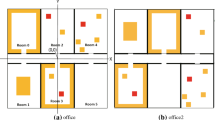Abstract
A main issue in cooperation in multi-agent systems is how an agent decides in which situations is better to cooperate with other agents, and with which agents does the agent cooperate. Specifically in this paper we focus on multi-agent systems composed of learning agents, where the goal of the agents is to achieve a high accuracy on predicting the correct solution of the problems they encounter. For that purpose, when encountering a new problem each agent has to decide whether to solve it individually or to ask other agents for collaboration. We will see that learning agents can collaborate forming committees in order to improve performance. Moreover, in this paper we will present a proactive learning approach that will allow the agents to learn when to convene a committee and with which agents to invite to join the committee. Our experiments show that learning results in smaller committees while maintaining (and sometimes improving) the problem solving accuracy than forming committees composed of all agents.
Similar content being viewed by others
References
Aamodt A. and Plaza E. (1994). Case-based reasoning: Foundational issues, methodological variations and system approaches. Artificial Intelligence Communications 7(1): 39–59. online at < url:http://www.iiia.csic.es/People/enric/AICom_ToC.html >.
Aha, D. (Ed.) (1997) Lazy learning. Kluwer Academic Publishers.
Brams S.J. and Fishburn P.C. (1983). Approval voting. Birkhauser, Boston
Breiman L. (1996). Bagging predictors. Machine Learning 24(2): 123–140
Cestnik, B., & Bratko, I. (1991). On estimating probabilities in tree pruning. In Machine learning-European working session on learning-91, Vol. 482 of Lecture Notes in Artificial Intelligence. (pp. 151–163). Springer Verlag.
Chan, P. K., & Stolfo, S. J. (1995). A comparative evaluation of voting and meta-learning on partitioned data. In Proceedings of the 12th international conference on Machine learning, pp. 90–98.
Cover T. and Hart P. (1967). Nearest neighbor pattern classification’. IEEE Transactions on Information Theory 13(1): 21–27
Dignum F., Dunin-Keplicz B. and Verbrugge R. (2001). Agent theory for eam formation by dialogue. Lecture Notes in Computer Science 1986: 150–166
Dutta, P. S., & Sen, S. (2002). Emergence of stable coalitions via task exchanges. In C. Castelfranchi, & W. L. Johnson (Eds.), Proceedings of 1st international conference on automous agents and multiagent systems, pp. 312–313.
Esteva, M., Padget, J., & Sierra, C., (To appear). Formalising a language for institutions and norms. In Intelligent agents VIII, proceedings ATAL’01.
Esteva, M., Rodriguez-Aguilar, J. A., Sierra, C., Garcia, P., & Arcos, J. L. (2001). On the formal specification of electronic institutions. In Agent mediated electronic commerce, Vol. 1991 of LNAI. Springer-Verlag.
Freund, Y., & Schapire, R. E. (1996). Experiments with a new Boosting algorithm. In Proceedings 13th international conference on machine learning, pp. 148–146.
Gama, J. (1998). Local cascade generalization. In Proceedings 15th international conference on machine learning, pp. 206–214.
Gomez, M., & Plaza, E. (2004). Extending matchmaking to maximize capability reuse. In Proceedings of the AAMAS 2004, pp. 144–152.
Hansen L.K. and Salamon P. (1990). Neural networks ensembles. IEEE Transactions on Pattern Analysis and Machine Intelligence 12: 993–1001
Leake, D. B. & Sooriamurthi, R. (2001). When two case bases are better than one: Exploiting multiple case bases. In ICCBR, pp. 321–335.
Leake, D. B. & Sooriamurthi, R. (2002). Managing multiple case bases: Dimensions and issues. In Proceedings of the 15th international Florida Artificial Intelligence Research Society (FLAIRS), pp. 106–110.
McGinty, L., & Smyth, B. (2001). Collaborative case-based reasoning: Applications in personalized route planning. In Case based reasoning ICCBR-01, pp. 362–376.
Ontañón, S., & Plaza, E. (2002a). A bartering aproach to improve multiagent learning. In 1st International joint conference in autonomous agents and multiagent systems.
Ontañón S. and Plaza E. (2002b). Collaboration strategies to improve multiagent learning. Lecture Notes in Artificial Intelligence 2430: 331–344
Ontañón S. and Plaza E. (2003a). Collaborative case retention strategies for CBR agents. Lecture Notes in Artificial Intelligence 2689: 392–406
Ontañón, S., & Plaza, E. (2003b). Justification-based multiagent learning. In International conference on machine learning ICML-2003, pp. 576–583.
Ontañón, S. & Plaza, E. (2005). Recycling data for multi-agent learning. In Proceedings 22nd international conference on machine learning ICML-2005, pp. 633–640.
Ontañón, S., & Plaza, E. (2006). Arguments and counterexamples in case-based joint deliberation. In Proceedings AAMAS’06 workshop on argumentation on multi-agent systems, p. to appear.
Ontañón S., (2005). Ensemble case based learning for multi-agent systems. Ph.D. thesis, Universitat Autònoma de Barcelona.
Perrone, M. P., & Cooper, L. N. (1993). When networks disagree: Ensemble methods for hybrid neural networks. In Artificial neural networks for speech and vision, Chapman-Hall.
Plaza, E., & Ontañón, S. (2001). Ensemble case-based reasoning: Collaboration policies for multiagent cooperative CBR. In I. Watson, & Q. Yang (Eds.), In case-based reasoning research and development: ICCBR-2001, pp. 437–451.
Plaza E. and Ontañón S. (2003). Cooperative multiagent learning. Lecture Notes in Artificial Intelligence 2636: 1–17
Quinlan J.R. (1986). Induction of decision trees. Machine Learning 1(1): 81–106
Wolpert, D. H. (1990). Stacked generalization. Technical Report LA-UR-90-3460, Los Alamos, NM.
Wooldridge, M., & Jennings, N. R. (1994). Towards a theory of cooperative problem solving. In Proceedings modelling autonomous agents in a multi-agent world (MAAMAW-94). (pp. 15–26). Odense, Denmark.
Author information
Authors and Affiliations
Corresponding author
Rights and permissions
About this article
Cite this article
Plaza, E., Ontañón, S. Learning collaboration strategies for committees of learning agents. Auton Agent Multi-Agent Syst 13, 429–461 (2006). https://doi.org/10.1007/s10458-006-0015-x
Published:
Issue Date:
DOI: https://doi.org/10.1007/s10458-006-0015-x




